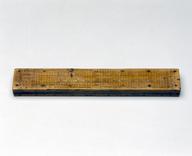

Donkin's Harmonograph for compounding two simple harmonic motions, made in 1871, with five printed sheets showing curves obtained by a slightly modified instrument made by Tisley and Spiller
Harmonographs are machines invented in the 1870s which used the motion of pendulums to draw curves. Arthur Edward Donkin designed this type of harmonoghraph in 1873 that used gears and wheels instead of pendulums to combine two simple harmonic motions (motion of bodies in state of vibration). The drawings on the paper were the result of motion given to both the pen and the cylinder to which the pen is secured around. Donkin donated this version of his harmonograph in wood to the museum in 1925.
Harmonographs mesmerised audiences in the 19th century with their motion and ability to draw beautiful designs. They were also used as demonstration devices in lectures and laboratories and particularly useful in the study of sound as a way to analyse vibrations. Following his father's footsteps, who was the mathematician William Donkin, Savilian Professor of Astronomy at the University of Oxford, Edward Donkin was a mathematics lecturer, fellow of Exeter College of the same university, with similar interest in the mathematical properties of sound vibrations, particularly the visualisation of the 'curves of pressure on the ear drum when certain simple tones or combinations of two simple tones are heard.' He added an article on compound harmonic curves at the second edition of his father's book on 'Acoustics' (1884).
In the 1980s the museum acquired drawings of curves made by a successor to Donkin's machine manufactured and sold by the firm of opticians and instrument makers Tilsey and Spiller at Brompton Road. The invention of the harmonograph has been attributed to Hugh Blackburn, Professor of Mathematics at Glasgow University in the 1840s but Tilsey has been closely associated with some of the first harmonographs' construction (as in H.Irwine Whitty's 1893 book 'The Harmonograph').
Details
- Category:
- Mathematics
- Object Number:
- 1925-285
- Materials:
- wood (unidentified) and metal (unknown)
- Measurements:
-
overall: 215 mm x 390 mm x 230 mm,
- type:
- drawing machines and harmonograph
- credit:
- Donkin, A.E.




